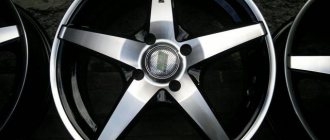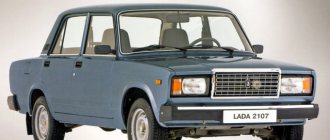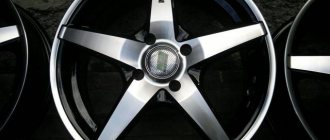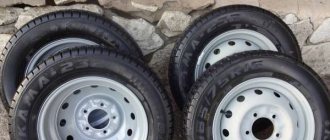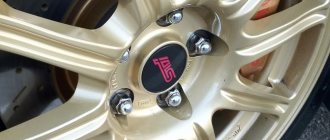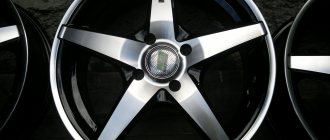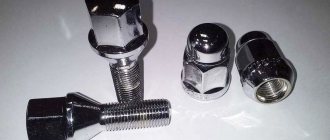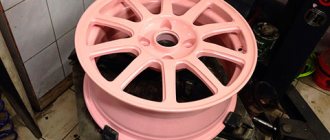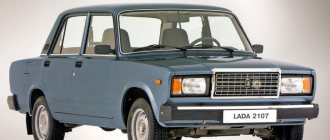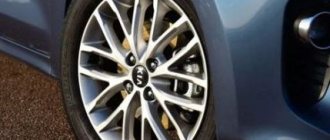The VAZ 2109 belongs to the Lada Sputnik family - a five-door modification of the previous model 2108 from the Lada Sputnik family.
Classic models came off the factory assembly line with standard rims stamped from a steel alloy:
- 4 1/2J-13;
- 4 1/2J-13H2;
- 5 J-13H2.
Before deciphering the markings, you need to understand what technical sizes and parameters of car wheels are accepted. Regardless of the manufacturing method, cast or stamped, they are designated in the same way. There is a mark on the outer surface that displays all the necessary information.
This includes:
- name of the manufacturing plant;
- the state where the release took place;
- date (based on the “week/year” principle, example: 1815 – 18th week of 2015);
- X-ray scan marking (light-alloy cast products are checked for the absence of internal cracks and defects);
- dimensions;
- sign of the control department (for Russia - ROSTEST, for Germany - TUV, international organization - ISO, for America - SAE, etc.);
- heat number and permissible load (lb (pounds), kg, example: max load 1800LB - maximum pressure up to 1800 pounds or 816 kg).
More details about standard sizes
All over the world it is common to use the European designation system. For example, simple wheels for tubeless on a VAZ-2109 are 4 1/2 J-13H2 ET30.
- J – coded parameters for the rim flange in mm (this includes rounding radii, tilt angles, etc.). This paragraph includes a list of dimensions to obtain a highly specialized conclusion when conducting technical tests. There are other categories - D, E, F, etc.
- H2 – double hump or annular offset of the rim flange HUMP (it keeps the tubeless tire from slipping). There are also such variations of humps - H (simple), A (asymmetrical), CH (combined), FH (flat).
13 – bore diameter in inches.
The drawing below clearly shows the main parameters for the structure of the arrangement of technological holes and protrusions.
- ET30 or ET+30 – wheel offset in mm. The dimensions of the distances between the middle of the width of the disk and the mating plane (where the disk and hub are in contact) are indicated, respectively equal to 30 mm. Based on where the product is manufactured, the marking changes to OFFSET (negative) or DEPORT (positive).
For a minus value, a designation with a similar sign is used, for example “-ET30”.
How to choose stamped products
VAZ 2109 with stamped rims
Stamped wheels are the most common for the VAZ 2109. Cars are equipped with these from the factory very often. This is due to the low cost of manufacturing such products.
They are not attractive in terms of design and have poor performance, but often car enthusiasts are attracted by their price. It is necessary to install stamped products on VAZs in compliance with the same requirements as for cast ones. Their parameters and sizes are fully consistent.
The dimensions and parameters common for the entire line of VAZ car models allow you to choose a set of wheels without any problems.
Mounting values on the disk (bolt pattern parameters)
When installing, it is important to take into account the fitting size recommended by the manufacturer, since differences may be due to different calculation systems (metric or imperial).
- The diameter distance between mounting holes is designated PCD (Pitch Circle Diameter). The accepted scheme on the VAZ-2109 looks like 4x98 or PCD 98/4, i.e. between the central axes of the bolts (4 pieces) 98 mm.
- Fastening elements - metric thread M12x1.25 (bolt stud diameter 12 mm and thread pitch 1.25 mm).
- The central hole for the hub shaft on the disk is designated DIA and for the VAZ-2109 this is equal to 58.5 mm.
Important! Often, car enthusiasts confuse PCD values due to a difference of just a couple of mm. For example, the standard size for the two central holes is just a visually imperceptible deviation of 2 mm - this is PCD at 4/98 and 100. Only 1 bolt will turn out to be completely tightened, and the remaining 3 will be undertightened, which will ultimately lead to an emergency.
Instructions for removing the hub assembly from the rear axle
- We turn off the engine, put the car in gear, and install stops under the front axle.
- We jack up the wheel we need.
- We tear off the mounting bolts and remove the removed wheel.
- Now we have access to the brake drum. Using a “12” wrench, unscrew the pin guides and remove it. The brake drum may be firmly in place. Then WD-40 universal lubricant will come to the rescue. And if the knot is stuck too tightly, you can remove it with a hammer or mallet, gently tapping it around the perimeter.
- Unscrew the hub nut.
- We remove the hub using a special two-jaw puller for VAZ bearings. If you don’t have one, you can simply screw the wheel to the axle and then quickly pull it off.
Installation of rims on R14, 15 on the VAZ-2109 model
The standard wheel with parameters 175/70 R13 is not particularly visually “noble” compared to the larger version R14 or R15. This is due to the large height of the rubber profile, which visually “overshadows” the already small dimensions of the disk.
Technical features of the VAZ-2109 model provide for the installation of wheels of categories R14 and R15 - forged or cast light alloy. The width of the discs can be from 5 to 6 inches with an offset characteristic of 35 to 40 mm. The remaining values regarding PCD and DIA correspond to 4x98 with a central connector diameter of 58.5 mm.
In this case, the selection of tires must be carried out on the basis that the overall diameter of the wheel is within the standard value. Failure to comply with this condition will result in the tire starting to rub the wheel arch liners and suspension parts while turning.
Advantages and disadvantages of low profile tires
With low-profile tires installed, the vehicle's maneuverability and controllability are significantly improved - this is especially noticeable when cornering. The steering wheel becomes “sharper” and the car practically does not deviate from the trajectory due to the fact that the low sides of low-profile tires crumple less under lateral loads on the tire.
But when driving on a bad road, such wheels transfer much more shock loads to the body than standard-sized tires, and absorb various road defects less well.
It is worth noting that a tire with a low profile is quite easy to “punch” to the disk even on a small pothole and at low speeds, and the edge of the alloy wheel can become wrinkled and completely fail when using such tires.
Also, it would not be amiss to mention that according to traffic rules it is prohibited to operate vehicles with tires whose characteristics do not correspond to the vehicle model. However, experience shows that traffic police officers usually have a calm attitude towards tuned VAZs with alloy wheels “14”.
And this is not surprising, because R14 wheels are standard equipment on cars of the VAZ 2110 family, the chassis of which is similar to the VAZ 2108, 2109 , 21093 and 21099 models. Riva, VAZ 2108-2109 Samara, VAZ 2110, VAZ 2112-2115: 4 x 98: 25 38: 58.0 Wheel sizes for minibuses. But with R15 alloy wheels, the likelihood of running into trouble when passing a technical inspection is much higher.
Method of calculations
Based on the tire characteristics of a standard 175/70 wheel with a radius of R13, where:
- values 175 and 70 are the values of the tire width and rubber profile height in percent;
- multiplying 175x0.7 together gives 122.5 mm;
- the actual diameter of the R13 disk is 13x25.39 will be 330 mm.
To find out the total diameter of the wheel, you need to add the two obtained values, but the profile height comes in double size, i.e. (122.5x2) is added to 330 and the result is 575 mm.
Calculations are carried out using the same principle for a more visual perception, for example: for models 175/70R13, 175/65R14 and 185/60R14, it comes out to 575, 583 and 577 mm, respectively.
The last value will be most suitable for the VAZ-2109, since it is 10 mm larger in width. This will reduce the braking distance during operation, add controllability, and reduce tire bending when cornering at high speed. Fuel consumption will increase slightly, but potholes and potholes on the road will become less noticeable.
Wheel sizes
Some of the most popular sizes for domestic cars are R14 and R15. Installation of such products is possible without any problems, provided that the overhang, width and drilling dimensions are observed. If a decision is made to install products that differ in size, then it is necessary to alter some components or purchase a set of spacers.
Note!
The problem with installing large wheels is the small wheel arches.
If you exceed the parameters without modifying the arches, then the tires in turns will touch the slats and arches, which will lead to high wear of all components and parts of the chassis.
To avoid such problems, you should purchase rims whose sizes are guaranteed to fit all parameters. The optimal sizes of 14 and 15 inches correspond to the factory settings for handling, dynamics and smoothness.
Wheels with a radius of R13 and R14 will give the maximum level of riding comfort.
As for large sizes, the decision to install them has its positive and negative sides, which are important to know. And the decision to purchase and replace wheels must be made by the car owner.
Pros:
- Improved car behavior on the road;
- Improving the appearance of the car;
- Maximum road performance, such as dynamics, handling;
- Better absorption of road surface defects;
- With high-profile tires installed, the wear resistance of the suspension increases;
- Reducing the braking distance.
You may be interested in NZ wheels – what brand?
Minuses:
- Reduced driving comfort, which is associated with the high sensitivity of the suspension to all road defects;
- Difficulty parking and driving on roads with problematic surfaces;
- Increased requirements for pressure control in low-profile tires;
- Increased fuel consumption, which is associated with the increased complexity of driving the wheels;
- High price of the kit.
Maximum and minimum parameters of non-standard disks
Tolyatti auto design engineers installed wheel rims with a radius of R15, but there are no direct reasons not to do this.
The problem is the difficulty of performing this operation without the involvement of specialists; the intervention of qualified craftsmen is necessary. The reason for this is the “conflict” of the rear arches and suspension parts with the new rims, and in some cases it is necessary to violate the factory design of the transmission.
Note! We should not forget about the mandatory technical inspection, and how traffic police officers will look at such an “upgrade”.
The suitable tire size for R15 wheels is 185/55 and even 195/50, but most likely such a large width will cause rubbing along the arch. Below are the recommended wheels for modifications to the VAZ-2109.
Kinds
Analyzing the wheel rim market, the entire range can be divided into three types:
- Stamped steel;
- Light alloy cast;
- Light alloy forged.
Steel
Many cars, including the VAZ 2109, were equipped with stamped wheels from the factory. Outwardly, they are completely unattractive, and over time they lose their external characteristics. Let's be honest, this is a relic of the past.
Cast
But at the same time, steel stampings have their advantages, due to which this type of disc is still produced and is in impressive demand among consumers:
- Affordable price. These are the cheapest options available today;
- High strength indicators. Considering the quality of our roads, many people think primarily about quality, safety, and not external data;
- Reliability. They do not have to be changed almost every season, which results in impressive savings;
- With strong impacts, the stampings do not break or crack. They crumple as much as possible, which opens up opportunities for recovery and restoration;
- Easy to remove and change without outside help.
But let's be completely honest. With all their positive qualities, the disgusting appearance forces car owners to abandon reliability and durability in favor of image and external attractiveness. Moreover, you should not think that light-alloy options are absolutely fragile and break only from one type of damage.
Forged
Light alloy
If we talk about alloy wheels, they are made, as you may have guessed, from special light alloys.
A total of three types of alloys are used.
| Alloy type | Peculiarities |
| Titanium | An excellent choice in all respects except cost. These are the most expensive alloy wheels, which, nevertheless, last a long time, are reliable, and look simply excellent. |
| Aluminum | Many people put aluminum alloy first, taking into account external characteristics, strength indicators and availability. An important advantage of aluminum is that it is not susceptible to corrosion. With proper use, aluminum alloy lasts a long time and maintains the excellent appearance of the car. |
| Magnesium | In the ranking among three light alloys it occupies the third place of honor. If you have the choice of titanium or aluminum, choose them. But this does not mean that magnesium alloys should be avoided. |
When choosing alloy wheel sets, be sure to compare their strengths and weaknesses. Appearance is far from the only criterion that you need to pay attention to when purchasing.
Advantages and disadvantages of light alloy
Compared to steel wheels, choosing light alloy options provides car owners with a fairly extensive list of advantages. But it is also important to know about the disadvantages.
| Advantages | Flaws |
|
|
In order to preserve the integrity of your beautiful, but not the most reliable, alloy wheels for a longer time, it is recommended to adhere to a few simple rules for their operation.
Tabular characteristics for selecting disks
Diameter R13
| Tire, mm/% | Disc size (width), inch | Reach value (ET), mm |
| 155/75; 165/70 | J5 | 35…38 |
| 175/70; 185/65 | J 5.5 | 35…38 |
Diameter R14
| Tire, mm/% | Disc size (width), inch | Reach value (ET), mm |
| 135/80 | J 4 | 45 |
| 165/65; 175/65; 185/60 | J 5.5 | 35…43 |
| 175/65; 185/60 | J 6 | 35…40 |
Diameter R15
| Tire, mm/% | Disc size (width), inch | Reach value (ET), mm |
| 185/55 | J 6 | 30 |
| 195/50; 195/55 | J 6.5 | 30 |
| 195/50; 205/50 | J 6.5 | 35 |
| 195/50; 205/50 | J 7 | 35 |
Description of design
The rear suspension is with 12 coil springs and 10 double-acting hydraulic telescopic shock absorbers.
The main load-bearing element of the suspension is a beam consisting of trailing arms 14 and a connector 13, welded together through reinforcements. At the rear, brackets 15 with eyes for attaching shock absorbers 10 and flanges for attaching the rear wheel axles and brake shields are welded to the suspension arms. At the front, the levers 14 are equipped with welded bushings with silent blocks 3 pressed into them. A bolt passes through the central bushing of the silent block, connecting the lever to the bracket 2. Three welded bolts are provided to secure the bracket to the body spar.
The suspension spring 12 rests with its lower end on a cup welded to the shock absorber reservoir, and with its upper end, through a rubber gasket 11, on a support welded from the inside to the body arch.
The lower eye of the shock absorber is bolted to bracket 15 of the suspension arm, and its rod is secured to the upper support of the suspension spring through two rubber pads 8 (one at the bottom of the support, the other at the top) and a support washer 7 (under the nut).
The rear suspension springs are divided into two stiffness classes according to their length in the free state and under load: A (more rigid, “high”) and B (less rigid, “low”). Springs of the same class must be installed on the front and rear suspensions. But in exceptional cases, if class A springs are installed in the front suspension, class B springs can be installed in the rear suspension (but not vice versa!). The quality of the springs can be fully assessed by the performance of the suspension on the car. If the suspension often “breaks through” to the bump stops on uneven roads or sags under load, stiffer springs should be installed. When replacing springs, do not forget to check the serviceability of the shock absorbers - after all, it is the shock absorber-spring pair that largely determines the characteristics of the suspension.
The hub has a double-row angular contact ball bearing, similar to the front wheel hub bearing, but smaller in size. The bearing fit on the axle is transitional (with slight interference or clearance). During operation, the bearing does not require adjustment or replenishment of lubricant. It is not allowed to eliminate the resulting play by tightening the nut; the bearing should be replaced. When dismantling the hub, the bearing is destroyed, so it is not recommended to disassemble the hub if the bearing is in good condition.
What wheels are recommended to be mounted on a VAZ-2109
The most suitable size wheels are 14 inches (R14). As stated above, installation of 15-inch ones is also allowed, but with low-profile tires. In this option, the stem should be in a gap between 30-35 mm, and tire models will fit this category: 185/55 or 195/50.
Large tires of the R15 series, for example 195/55 or 205/50, are suitable for mounting on the front axle. In order to insert them onto the rear axle, structural modifications to the suspension design and enlargement of the wheel arches will be required. The optimal sizes for installation on the VAZ-2109 are models 185/60 for R14 and 195/50 for R15.
On the ninth fret model, it is beneficial to carry out external tuning by replacing wheels, since this method is budget-friendly. It can be done on your own without any problems, if you do not try to mount very large rims.
Removing the hub
To remove the rear wheel hub of a VAZ-2108, you will need to perform a few simple manipulations:
- Completely unscrew the wheel bolts.
- Remove the wheel.
- Unscrew the nut that is located on the hub.
- Using a 12mm wrench, unscrew the studs that secure the brake drum to the wheel hub.
- Place these pins in adjacent holes and tighten them evenly. This way you will be able to move the brake drum from its place. If this does not help, you need to carefully knock the drum out of its place using a hammer and a wooden spacer.
- Use long bolts; they need to be screwed into two opposite holes on the hub. It is necessary to tighten them until the hub begins to move out of its place. You can also use a three-jaw puller for this purpose. The last resort is to install the back of the wheel and pull it with your hands.
- Sometimes the inner race of the bearing remains on the axle. It needs to be removed. To do this, first, using a chisel, you need to slightly move this ring on the axis, and then install a puller with two legs. After dismantling, be sure to check that there is no damage to the axle. Otherwise, clean the metal with a fine file.
wwss75 › Blog › Front wheel spacers for maintenance-free bearing 2108
I rewrote it, corrected it, added it. part 1. HURRAY! It’s done, I’m holding the spacers in my hands. I've been wanting to make one for myself for a long time. It’s extremely difficult with a budget and purchasing via the Internet is no longer necessary. I couldn’t find it on sale in St. Petersburg and heard a price tag of 2,000 rubles. I contacted turners a couple of times and was shocked by their price of about 6,000 rubles. for work. Andryukha's old friend came to the rescue. I found the time and, according to the drawing, turned it out of 45 steel, accurate to the hundredth. I didn’t take the money :)) FRIEND! :)) I took the drawing from timur911, here is the link at www.drive2.ru/l/4438002/ In my drawing, 2 dimensions have been changed for a tighter fit of the spacer on the axle. Plus, the manufacturing accuracy of the two seating surfaces is 0.01-0.03 mm. (When making the inner surface, the turner makes dissatisfied faces and says that it is lazy and difficult to do) So, my version is a trial one! The final dimensions will become clear after installation on the car. I'll definitely write back. (A year and a half later, everything is EXCELLENT! Everything works! The drawing was corrected and correct 09/07/16.)
